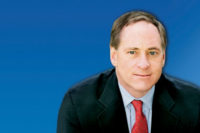As within all sectors, there has been tremendous change and progress since 9/11 by enabling business to be conducted, securely. And the discussion and takeaways at NCS4, while focused on sports and entertainment, can be applied across many sectors for security leaders everywhere. Commissioner Goodell also shared that “My key to a successful security program is that no one is talking about you and that you are not the focus of the sporting event.” It is interesting to recognize how seamlessly security and safety have been integrated into the New Meadowlands Stadium (please see “A Touchdown for Security” in our August 2010 issue) versus how present it was at the first major league championship after 9/11 – the 2002 Super Bowl in New Orleans.
“The way the game was attended changed at that Super Bowl,” Commissioner Goodell said. “Magnetometers and pat downs were first used there and the game was identified by the government as a national security event. Terror is real. Risk is real. And vigilance must continue. The challenge is to provide a safe environment that is also a fun experience. We talk and listen to the fans. While our focus includes worst scenarios, the fan’s major deterrent to attending a game is not terror. It is being able to bring their families and not be disturbed by other, unruly fans. They want to be able to alert authorities to a problem. All 32 teams will be using texting this year as a result.”
Increasingly, the Department of Homeland Security has taken an interest in security at spectator sports and entertainment. DHS Secretary Janet Napolitano spoke about the aftermath of Hurricane Katrina and the role that the New Orleans Superdome played during that disaster. As my (rudimentary) chart shows, while DHS is focused on the high-risk/low-probability events, such as the Government commandeering a major sports facility and terror attacks, the NCS4 program content was mostly focused on the real world activities of their members, which primarily include crowd control and alcohol abuse. While terror is top of mind and requires a major investment due to its high national, cultural impact, it is the low-impact, high-frequency, crowd control and incident management actions, mostly related to alcohol abuse (high frequency/low impact) that require the most time and attention.
One of the new and successful programs that started in New York City and that DHS is adopting nationally is “See Something, Say Something” (Please see The Zalud Report on page 98). “The threat is constant and very real,” noted Secretary Napolitano, reminding the audience that a food cart vendor in New York City was critical to thwarting the Times Square bombing on May 1, 2010 and that this program will have an increasing impact on public safety.
The overall theme of the conference speakers reiterated that preparation, planning, communication and training/drilling/practice (don’t be complacent) is critical for situational awareness and prevention. Among the best examples of preparation and planning discussed the conference was U.S. Flight 1549 and Captain Chesley Sullenberger’s successful landing in the Hudson River on January 15, 2009. “Sully” was well prepared for many years and once said, “One way of looking at this might be that for 42 years, I’ve been making small, regular deposits in this bank of experience: education and training. And on January 15, the balance was sufficient so that I could make a very large withdrawal.” A valuable takeaway for everyone in the security profession. (FYI: Sullenberger is speaking at ASIS 2010 in Dallas).
